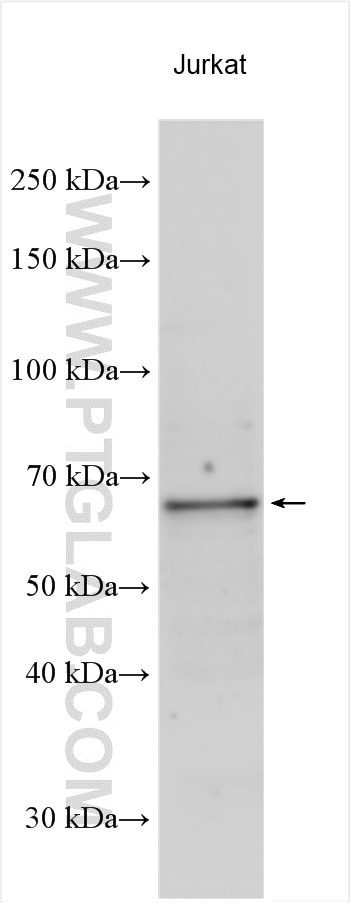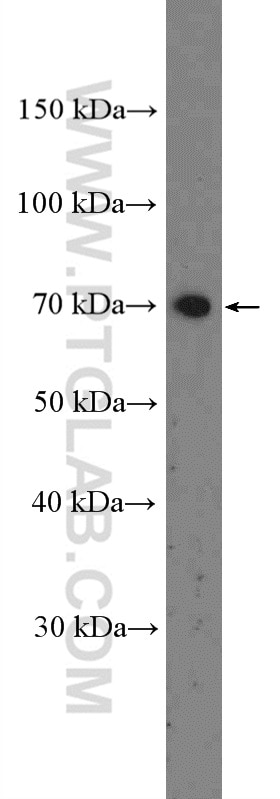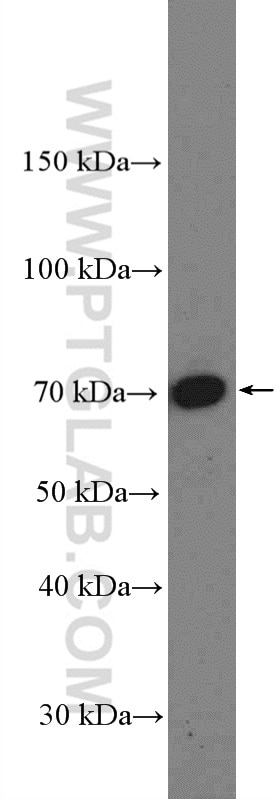Validation Data Gallery
Tested Applications
| Positive WB detected in | Jurkat cells, HL-60 cells |
Recommended dilution
| Application | Dilution |
|---|---|
| Western Blot (WB) | WB : 1:500-1:1000 |
| It is recommended that this reagent should be titrated in each testing system to obtain optimal results. | |
| Sample-dependent, Check data in validation data gallery. | |
Product Information
12825-1-AP targets MLLT3/AF9 in WB, ELISA applications and shows reactivity with human, mouse, rat samples.
| Tested Reactivity | human, mouse, rat |
| Host / Isotype | Rabbit / IgG |
| Class | Polyclonal |
| Type | Antibody |
| Immunogen | MLLT3/AF9 fusion protein Ag3528 相同性解析による交差性が予測される生物種 |
| Full Name | myeloid/lymphoid or mixed-lineage leukemia (trithorax homolog, Drosophila); translocated to, 3 |
| Calculated molecular weight | 568 aa, 63 kDa |
| Observed molecular weight | 63-70 kDa |
| GenBank accession number | BC036089 |
| Gene Symbol | AF9/MLLT3 |
| Gene ID (NCBI) | 4300 |
| RRID | AB_2145949 |
| Conjugate | Unconjugated |
| Form | Liquid |
| Purification Method | Antigen affinity purification |
| UNIPROT ID | P42568 |
| Storage Buffer | PBS with 0.02% sodium azide and 50% glycerol{{ptg:BufferTemp}}7.3 |
| Storage Conditions | Store at -20°C. Stable for one year after shipment. Aliquoting is unnecessary for -20oC storage. |
Background Information
MLLT3, also named as AF9, YEATS3, is a 568 amino acid protein, which is a component of the superelongation complex6 and co-operates with DOT1L, which di/trimethylates H3K79 to promote transcription. MLLT3 localizes to active transcription start sites (TSSs) through the YEATS domain, which recognizes active histone marks such as H3K9 acetylation and crotonylation. A truncated MLLT3 that lacks the YEATS domain forms a leukaemic fusion protein with the N terminus of MLL1, which misdirects MLLT3-interacting complexes to induce aberrant gene transcription. MLLT3 also regulates erythroid or megakaryocytic progenitors and was identified as a definitive HSC hub gene during mouse development. Researcher found that the expression of a gene called MLLT3 was closely correlated with blood stem cells'potential to self-renew and that the protein generated by the MLLT3 gene provides blood stem cells with the instructions necessary to maintain its ability to self-renew. It does this by working with other regulatory proteins to keep important parts of the blood stem cell's machinery operational as the cells divide.
Protocols
| Product Specific Protocols | |
|---|---|
| WB protocol for MLLT3/AF9 antibody 12825-1-AP | Download protocol |
| Standard Protocols | |
|---|---|
| Click here to view our Standard Protocols |


